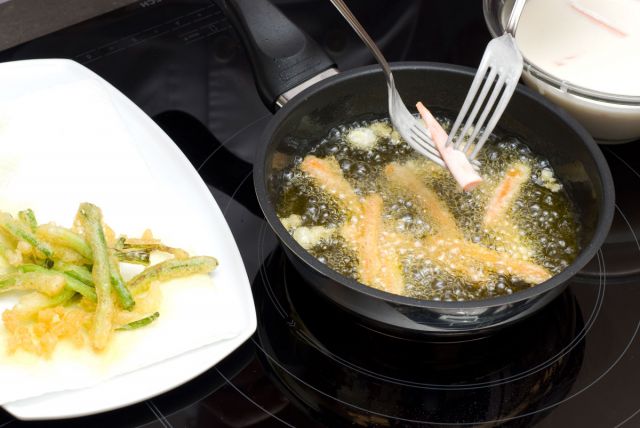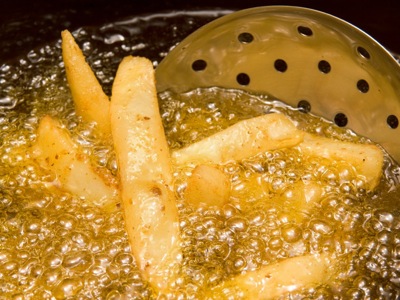Can we really fry with Extra Virgin Olive Oil? Should we? Is it not just a waste of money? Should we be frying food full stop?
I wrote about this subject a few years back but I still get numerous questions and comments related to frying with olive oil. There are still many many people who have the understanding that you shouldn't fry with olive oil because "it is said" to be carcinogenic. This is is totally unfounded, so I thought I might clear up many doubts surrounding this subject with the hope that people will spread the word; Olive Oil is good for everything! Frying is one of the oldest forms of cooking common to all of the Mediterranean Basin: Europe, Asia and Africa.  In short the homeland for the Olive Tree. As a method of cooking it is dominant in all cultures and religions scattered throughout the region.
In short the homeland for the Olive Tree. As a method of cooking it is dominant in all cultures and religions scattered throughout the region.
Investigations have shown that frying is actually beneficial to the organism, particularly from the physiological point of view contrary to general opinion. “But fried food is fatty and can’t be digested properly and it gives me a heavy stomach” is an all too common remark. Whether the food that is fried is digested easily or weighs down your stomach depends to a great extent on the type of oil used, the temperature of the oil and the manner in which the food was fried. Yes, even frying has its art form!
Studies undertaken on healthy subjects and patients with gastro-duodenal problems (gastritis, ulcer, liver and biliary complaints) have shown that there is no relationship between food fried in olive oil and these illnesses.
It all comes down to how edible oils deteriorate when heated. All oils will eventually suffer an alteration in their chemical structure when exposed to high temperatures. The alteration undergone by vegetable oils when heated for frying is far quicker, creating far more fatty acids, particularly from seed oils and more so if the initial acidity of the oil was already high. It will always be more stable if it has a high content of natural antioxidants - vitamin E - polyphenols. This alteration also varies according to temperature and the length of time heated, the number of times the oil is used and the manner of frying, if it is continuous frying it changes less and the type of food being fried is also a determining factor when using vegetable oils. Frying fish, especially oily fish, increases the polyunsaturated acid content of the oil, facilitating its rapid decomposition. So you better hope your local fish & chips shop changes their oil regularly if they use sunflower oil.
This is where the real benefits of extra virgin olive oil come to light. Extra virgin olive oil is ideal for frying. In proper temperature conditions, without over-heating, it undergoes no substantial structural change at all and keeps its nutritional value far better than other oils, not only because of the antioxidants but also due to its high levels of oleic acid (good fatty acids). It has a very high smoking point of 210ºC which is substantially higher  than the ideal temperature for frying food which any cook will tell you is around 180-185ºC. Those fats with lower critical points, such as corn and butter, break down at this temperature and form toxic products. I highly recommend purchasing a kitchen thermometer, you can find them on Amazon for less than 10 euros.
than the ideal temperature for frying food which any cook will tell you is around 180-185ºC. Those fats with lower critical points, such as corn and butter, break down at this temperature and form toxic products. I highly recommend purchasing a kitchen thermometer, you can find them on Amazon for less than 10 euros.
“My chips were all greasy and full of oil!” Well, they were probably fried with vegetable oil (as seen in the picture). Apart from it being healthier, one of the best reasons for using extra virgin olive oil for frying is that it forms a crust on the surface of the food that impedes the penetration of oil and improves its flavour. Food fried in extra virgin olive oil has a much lower fat content than food fried in other oils, making extra virgin far more suitable for weight control. Extra virgin olive oil, is the most suitable, the lightest and the tastiest medium for frying.
It is an oil that goes much further than other oils, and not only can it be re-used more often than others, it also increases in volume when reheated, so less is required for cooking and frying. This is one major fact to take on board when evaluating the cost. You won’t need to waste as much oil. There is no problem in re-heating extra virgin olive oil even up to 3 or 4 times and in some cases more, although I doubt anyone would actually do it! The higher the polyphenol content in the extra virgin the longer it will last and it is the polyphenols that protect the oil from the heat. Picual varieties tend to be very high in polyphenols, so medium to a robust extra virgin is ideal.
The digestibility of heated extra virgin olive oil does not change even when re-used for frying several times. The only thing that will be altered is that it will adopt the flavour, as will any oil, of what you previously fried in it. But if you use a certain amount just for chips/potatoes you can re-use it over and over in your deep fat fryer, something that is not so advisable for vegetable oils and nonetheless everyone still does it. Extra Virgin Olive oil should not be mixed with other fats or vegetable oils and should not generally be used more than four or five times. The oil used for frying should always be hot; if it is cold the food will soak up the oil, no matter what oil it is. It needs to be hot to form a sealed crust.
Don't forget 185º is my sweet spot and be careful not to put too much food in the oil especially if it is frozen.